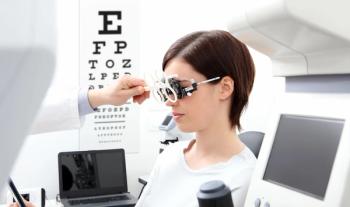
Managing dry eye in 2025: Think bigger picture, multisystem
Dry eye disease (DED) continues to grow in prevalence and complexity, challenging eye care practitioners to adopt new tools and evolving treatment methods. As we head into 2025, practitioners should consider the bigger picture when it comes to understanding the causes of dry eye and embrace a multifaceted approach to treatment to achieve better patient outcomes.
Examining all the root causes of dry eye
Dry eye does not exist in isolation. It is a multifactorial disease that can be influenced by dermatologic, anatomic, and aging-related factors. When we recognize this complexity, we can uncover underlying causes of dry eye in our patients that may otherwise go unnoticed and address them accordingly, providing more effective treatment.
Skin inflammation, particularly rosacea, frequently overlaps with DED, contributing to ocular surface inflammation and meibomian gland dysfunction (MGD). Several dermatologic conditions, including rosacea, blepharitis, atopic dermatitis (eczema), psoriasis, and even seborrheic dermatitis, can play a role, as they often affect the eyelids and surrounding skin, potentially disrupting the tear film production and leading to symptoms of dryness and irritation in the eyes.
On the anatomic front, there are numerous conditions that can set the stage for significant meibomian gland dropout, even in young adults. Some examples include sleep apnea, chronic allergic rhinitis, mouth breathing, nocturnal lagophthalmos, and incomplete blinking—conditions that expose the ocular surface and exacerbate tear evaporation.
Aging can also introduce challenges, such as changes in lid mechanics, facial volume loss, and reduced meibum production, which further contribute to dry eye symptoms. These issues are often compounded by medications used to treat various medical conditions that arise with age.
Practitioners must move beyond an eye-centered approach to dry eye management. By expanding your expertise to include an enhanced understanding of how dermatology, neurology, oculoplastics, otolaryngology, and autoimmune disorders can all play a role in contributing to DED, you elevate the level of care delivered to patients and help facilitate better outcomes.
Expanding energy-based device services
Energy-based devices are revolutionizing how we treat dry eye. As prior authorization hurdles continue to rise, these in-office solutions will become an increasingly popular option for practitioners and patients:
- Intense pulsed light (IPL) remains my first treatment of choice for treating DED due to MGD. Findings from studies show that IPL can significantly reduce inflammatory markers in tears of patients experiencing DED due to MGD after IPL treatment.1 There is still only 1 FDA-approved IPL device, which is OptiLIGHT from Lumenis. A 2024 IPL report found only approximately 27% of optometrists in the US currently own or have access to an IPL device.2 This means there is still an opportunity to be an early adopter of this technology—which has been shown to significantly improve tear breakup time, meibum quality, and meibomian gland expressibility—and differentiate your practice.3 When it comes to patient results, I find I can get further with IPL technology than with anything else in my tool kit.
- The benefits of radio frequency (RF) go beyond melting meibum and tissue tightening. These treatments help reduce inflammation, provide neuromodulation effects, and alleviate pain, making it especially useful for patients experiencing significant pain with their ocular surface disease.4 The addition of OptiPLUS has expanded our treatment offerings to meet our patients’ needs. OptiPLUS differs from other RF technologies in that it uses a monopolar application rather than a bipolar application, which mitigates the risk of electrical arcing and offers a more rapid and even heating of deeper eyelid tissue.5 Monopolar application creates time efficiencies, and dual-frequency RF enhances tissue treatment effects.
- Dynamic Muscle Stimulation therapy (DMSt) is another exciting new approach to supporting the dry eye patient. It strengthens the orbicularis and facial muscles, similar to how a trainer strengthens the muscles of the body. DMSt, developed by Lumenis, is offered to patients with weak orbicularis function or incomplete blinking, and we are seeing significant clinical improvements. By restoring proper blink mechanics and muscle tone to the orbicularis, DMSt helps restore the eyelid’s natural ability to protect the eye from evaporation while complementing other treatments such as IPL, gland expression, and perfluorohexyloctane.
- Several other emerging tools are available, including in-office medical-grade low-level light therapy, which is a helpful adjunct in addressing dermatologic inflammation associated with DED. Another technology, recently FDA cleared for the treatment of MGD, employs a thermomechanical strategy and has demonstrated noninferiority to LipiFlow.
Given the many co-conspirator conditions associated with dry eye, a multisystem, multitreatment approach is essential, and these modalities represent the future of comprehensive dry eye care.
Emerging targeted pharmacologic therapies
The next generation of pharmacologic therapies promises more precise, mechanism-specific treatment options for DED. Moving beyond broad-spectrum anti-inflammatories, the latest advancements target specific pathways:
- Reproxalap is a promising upstream inflammation mitigation strategy. Aldehydes are found at high levels in dry eye and at increasing levels with MGD severity. Reproxalap absorbs aldehydes, which are key amplifiers of inflammation triggered by oxidative stress. Pending FDA approval, which is expected in 2025, reproxalap may provide a significant leap forward in managing inflammatory DED and possibly also MGD.
- Acoltremon is a topical ophthalmic that activates TRPM8 corneal neural receptors that naturally stimulate tear production. By leveraging the body’s protective response to temperature changes, particularly in cold environments, acoltremon stimulates the front line of the lacrimal functional unit via neuroreceptor stimulation, thereby enhancing tear film production. It is also pending FDA approval.
These emerging therapies show great potential and expand our treatment options to target specific inflammatory and neurosensory factors of dry eye. I hope to see these new options come to market later this year.
Final thoughts
Dry eye management in 2025 will require eye care practitioners to think holistically, embrace advanced technologies, and stay informed about the latest therapies. As our options expand, it can feel overwhelming to determine the best way to incorporate them into our practices, but the key is to stay curious and keep learning.
To expand your knowledge, consider attending advanced courses at professional conferences, joining and engaging in practitioner-focused online discussion groups, and tracking innovations in dry eye through tools such as Google Scholar Alerts.
By taking a steady, deliberate approach to learning, adopting new tools, and understanding the mechanisms behind each treatment, we can become more effective in helping our patients combat dry eye and improve their daily lives.
References
1. Liu R, Rong B, Tu P, et al. Analysis of cytokine levels in tears and clinical correlations after intense pulsed light treating meibomian gland dysfunction. Am J Ophthalmol. 2017;183:81-90. doi:10.1016/j.ajo.2017.08.021
2. The 2024 IPL Report. Eyes on Eyecare. December 5, 2024. Accessed December 20, 2024. https://eyesoneyecare.com/resources/the-2024-ipl-report/
3. Dell SJ. Significantly improved signs of dry eye disease: key findings from FDA study of Lumenis light therapy. Lumenis. November 7, 2022. Accessed January 6, 2025. https://lumenis.com/vision/resource-hub/significantly-improved-signs-of-dry-eye-disease-key-findings-from-fda-study-of-lumenis-light-therapy/
4. Park D, Chang MC. The mechanism of action of pulsed radiofrequency in reducing pain: a narrative review. J Yeungnam Med Sci. 2022;39(3):200-205. doi:10.12701/jyms.2022.00101
5. Green JB, Dover JS, Kaminer MS. Tolerability of a monopolar radiofrequency facial skin tightening procedure: an observational study. Cosmet Dermatol. 2011;24(7):327-330. https://cdn.mdedge.com/files/s3fs-public/Document/September-2017/024070327.pdf
Newsletter
Want more insights like this? Subscribe to Optometry Times and get clinical pearls and practice tips delivered straight to your inbox.
















































.png)


